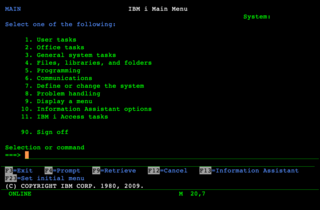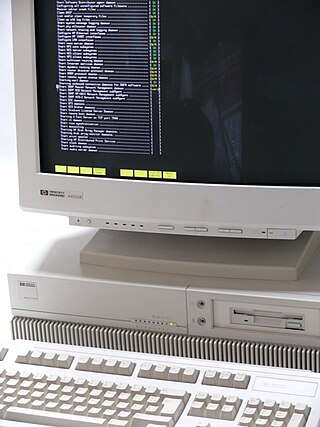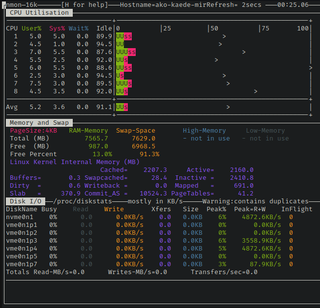External links
Executable and object file formats | |
|---|---|
| Filename extension | none, .o |
|---|---|
| Developed by | IBM |
| Type of format | Binary, executable, object, shared libraries |
| Extended from | COFF |
XCOFF, for "eXtended COFF", defined by IBM and used in AIX, is an improved and expanded version of the COFF object file format. Early versions of the PowerPC Macintosh also supported XCOFF, as did BeOS.
XCOFF additions include the use of CSECTs to provide subsection granularity of cross-references, and the use of stabs for debugging. Information for the handling of shared libraries is also more elaborate than for plain COFF.
More recently, IBM defined an XCOFF64 version supporting 64-bit AIX, and used XCOFF32 to mean the original file format.

AIX is a series of proprietary Unix operating systems developed and sold by IBM for several of its computer platforms.
Waveform Audio File Format is an audio file format standard, developed by IBM and Microsoft, for storing an audio bitstream on personal computers. It is the main format used on Microsoft Windows systems for uncompressed audio. The usual bitstream encoding is the linear pulse-code modulation (LPCM) format.
Journaled File System (JFS) is a 64-bit journaling file system created by IBM. There are versions for AIX, OS/2, eComStation, ArcaOS and Linux operating systems. The latter is available as free software under the terms of the GNU General Public License (GPL). HP-UX has another, different filesystem named JFS that is actually an OEM version of Veritas Software's VxFS.
In Unix and Unix-like operating systems, chmod is the command and system call used to change the access permissions and the special mode flags of file system objects. Collectively these were originally called its modes, and the name chmod was chosen as an abbreviation of change mode.
In computing, Deflate is a lossless data compression file format that uses a combination of LZ77 and Huffman coding. It was designed by Phil Katz, for version 2 of his PKZIP archiving tool. Deflate was later specified in RFC 1951 (1996).

IBM i is an operating system developed by IBM for IBM Power Systems. It was originally released in 1988 as OS/400, as the sole operating system of the IBM AS/400 line of systems. It was renamed to i5/OS in 2004, before being renamed a second time to IBM i in 2008. It is an evolution of the System/38 CPF operating system, with compatibility layers for System/36 SSP and AIX applications. It inherits a number of distinctive features from the System/38 platform, including the Machine Interface, the implementation of object-based addressing on top of a single-level store, and the tight integration of a relational database into the operating system.

VM is a family of IBM virtual machine operating systems used on IBM mainframes System/370, System/390, zSeries, System z and compatible systems, including the Hercules emulator for personal computers.
The Common Object File Format (COFF) is a format for executable, object code, and shared library computer files used on Unix systems. It was introduced in Unix System V, replaced the previously used a.out format, and formed the basis for extended specifications such as XCOFF and ECOFF, before being largely replaced by ELF, introduced with SVR4. COFF and its variants continue to be used on some Unix-like systems, on Microsoft Windows, in UEFI environments and in some embedded development systems.
An object file is a file that contains machine code or bytecode, as well as other data and metadata, generated by a compiler or assembler from source code during the compilation or assembly process. The machine code that is generated is known as object code.

Unix System V is one of the first commercial versions of the Unix operating system. It was originally developed by AT&T and first released in 1983. Four major versions of System V were released, numbered 1, 2, 3, and 4. System V Release 4 (SVR4) was commercially the most successful version, being the result of an effort, marketed as Unix System Unification, which solicited the collaboration of the major Unix vendors. It was the source of several common commercial Unix features. System V is sometimes abbreviated to SysV.
pax is an archiving utility available for various operating systems and defined since 1995. Rather than sort out the incompatible options that have crept up between tar and cpio, along with their implementations across various versions of Unix, the IEEE designed new archive utility pax that could support various archive formats with useful options from both archivers. The pax command is available on Unix and Unix-like operating systems and on IBM i, and Microsoft Windows NT until Windows 2000.
The Microsoft Macro Assembler (MASM) is an x86 assembler that uses the Intel syntax for MS-DOS and Microsoft Windows. Beginning with MASM 8.0, there are two versions of the assembler: One for 16-bit & 32-bit assembly sources, and another (ML64) for 64-bit sources only.
Advanced Function Presentation (AFP) is a presentation architecture and family of associated printer software and hardware that provides for document and information presentation independent of specific applications and devices.
IBM Storage Protect is a data protection platform that gives enterprises a single point of control and administration for backup and recovery. It is the flagship product in the IBM Spectrum Protect family.
Extended file attributes are file system features that enable users to associate computer files with metadata not interpreted by the filesystem, whereas regular attributes have a purpose strictly defined by the filesystem. Unlike forks, which can usually be as large as the maximum file size, extended attributes are usually limited in size to a value significantly smaller than the maximum file size. Typical uses include storing the author of a document, the character encoding of a plain-text document, or a checksum, cryptographic hash or digital certificate, and discretionary access control information.
Configuration Management Version Control (CMVC) is a software package that serves as an object repository, and performs software version control, configuration management, and change management functions.
The Object Module Format (OMF) is an object file format used primarily for software intended to run on Intel 80x86 microprocessors. It was originally developed by Intel around 1975–1977 for ISIS-II, targeting the 8-bit 8080/8085 processors. This variant later became known as OMF-80. As OMF-86 it was adapted to the 16-bit 8086 processor in 1978. Version 4.0 for the 8086 family was released in 1981 under the name Relocatable Object Module Format, and is perhaps best known to DOS users as an .OBJ file. Versions for the 80286 (OMF-286) and the 32-bit 80386 processors (OMF-386) were introduced in 1981 and 1985, respectively. It has since been standardized by the Tool Interface Standards Committee and was also extended by Microsoft and IBM (IBM-OMF). Intel also adapted the format to the 8051 microcontroller (OMF-51 and AOMF).

nmon is a computer performance system monitor tool for the AIX and Linux operating systems. The nmon tool has two modes a) displays the performance stats on-screen in a condensed format or b) the same stats are saved to a comma-separated values (CSV) data file for later graphing and analysis to aid the understanding of computer resource use, tuning options and bottlenecks.
The Linear Tape File System (LTFS) is a file system that allows files stored on magnetic tape to be accessed in a similar fashion to those on disk or removable flash drives. It requires both a specific format of data on the tape media and software to provide a file system interface to the data.